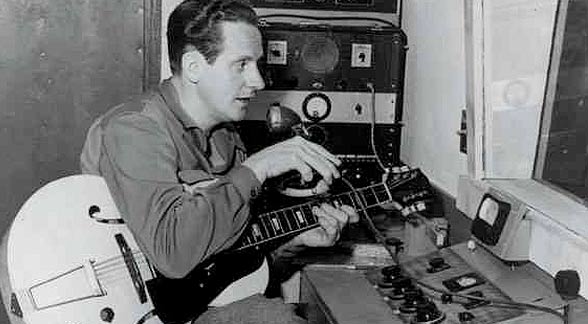The Magic of Multitracking
Les Paul, guitarist, engineer and instrument designer, forever changed the process of commercial record production with his perfection of “ping ponging” and ovedubbing in the 1950s. Recording engineers and producers were no longer required to capture an entire selection of music at a time. His innovations allowed music to be assembled by layering multiple passes of musical parts on top of each other. His contribution to the music industry that we know today cannot be underestimated.
These days the vast majority of music that we hear on the radio, in movie theaters, on our personal devices and reproduced on physical media was recorded using multitrack audio equipment and procedures. Even the recordings that I produce as single sessions without overdubs are captured on 24-36 individual audio tracks, an innovation that Les Paul didn’t invent but did advance tremendously.
Analog tape machines and blank tape arrived in the states after WWII (Jack Mullins, a member of the signal corps appropriated it from the Germans) and companies like Ampex started manufacturing new hardware. Bing Crosby was one of the first to recognize the tremendous opportunities that analog tape recording offered and invested $50,000 in Ampex, which was formed by Jack Mullins. Ampex created the world’s first commercially available analog tape machine, the Ampex 200. Bing could record a whole week’s worth of his radio program rather than being in the studio at show time every day.
Les Paul and his wife/musical collaborator singer Mary Ford were major stars in the early 50s. They sold over 6 million records and had a long string of hits. Les customized his Ampex 200 machine (the second one manufactured) by adding an additional playback head before the record head. This additional head would playback whatever was on the full track mono machine (there was only a single audio track across the entire width of the tape) while Les (or his wife Mary) performed another musical part. The existing track and the new part were mixed together and recorded back on the same piece of tape thus destroying the original track. This technique is known as “ping ponging” or sound on sound.
The productions that Les Paul engineered in his studio with this approach were very different from previous recordings. Eventually Ampex produced an 8-track machine in the late 50s and Les bought the first one. With multiple tracks, he was able to stack musical parts on different tracks without any erasing. All analog multitrack recorders can record and playback individual tracks from the same head at the same time. The history of recording technology took a major leap forward.
Most commercial records are produced using multitrack procedures. The rhythm instruments, drums, bass, piano, guitar and scratch vocals, are recorded onto 5-12 tracks or more during what’s called a “tracking session”. After the song’s basic track is locked down, additional musicians/singers are brought in one at a time to “overdub” more parts on new tracks in sync with the rhythm track. This process continues until the producer, artist and engineers are satisfied.
In the early days of multichannel recording when the machines had only 4 to 16 tracks, the engineer would use Les Paul’s technique of “ping ponging” some of the tracks to fewer tracks (usually a stereo pair) by carefully doing a mix of those tracks. Then the original source tracks were erased, which made room for more new parts to be added. As track counts increased and the ability to lock two 24-track machines together was developed, the use of sound on sound disappeared.
The final stage of record production is the mixing of all of the tracks to a stereo master. Each track from the multitrack machine is routed through a channel strip on a large format analog mixing console and then merged or mixed to a stereo mixing bus. The output of the stereo bus or mix bus is sent to a half-track stereo mixdown machine. The mixing engineer adds special effects, modifies the timbre of the tracks, distributes them in the stereo field and adjusts the relative volume during the mixdown process. This process establishes the sound of production up to the ultimate mastering stage, which further refines the overall sound.
The music business turned a major corner when the “magic of multitracking” was introduced. The kinds of records, the sounds and the studio business itself would not have happened if not for this critical development.
And a great of credit goes to Les Paul.

